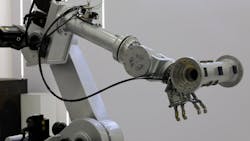There were few complaints. People weren’t returning products and demanding refunds. But Hubert Dubois, general manager of Quebec, Canada-based custom kitchen cabinet manufacturer Fabridor knew there was a problem. They were losing customers.
It was a difficult problem to quantify because repairing doors built from medium-density fiberboard (MDF) is easier than returning them and quicker than waiting for a fresh run. But when complaints did come in, they were always based on quality issues.
The Fabridor plant employs 55 people and historically manufactures around 300 doors per day and pulls only one door for testing from each shift. Quality errors around sanding may remain invisible until wood doors are painted. The plant doesn’t run a paint shop and cannot support multiple, rapid paint jobs, hence the low sample rate.
When doors did fail quality checks, operators had to pull doors from previous shifts, paint them, determine which batch contained the quality error and re-sand the entire batch.
Too many QA checks would tank productivity. Error correction paused production. Hubert Dubois, general manager of Fabridor, decided the answer lay with robotics.
When Trust Beats ROI
Dubois had prior manufacturing experience with robotics and trusted the technology in a general sense. One of the two brothers that run Fabridor parent company Cabcor Industries did not.
“He is really not keen on new technology. He likes to buy machines that have proven themselves, not really anything that is new or specifically made for a specific task, like we [needed]. So, I had a lot of convincing to do with him,” says Dubois.
Fabridor is a high mix/low yield job shop, which made ROI projections difficult. Dubois predicated the pitch on saving one position per shift by switching to automation. Deploying a pair of sanding robots would cost a little less than $288,000 when in the past five years Fabridor had posted 5% profit annually off about $5 million in gross income. The robots represented a significant financial risk.
Faith in Dubois’s judgement ultimately led to approval of the PO.
“They’d been trying to hire me for a few years, so they knew what I was capable of doing from the get-go. When I decided to come work with them, I also had their agreement [that] they were going to trust me. … I had to [play] that card…because one of the CEOs didn’t really believe robotics was a good solution. It was a risky solution,” says Dubois.
Where he had based his executive pitch substantially on trust, Dubois couldn’t afford to leave the success of the project to faith.
“We found that the most important thing was … the will of the integrator to work on a sanding pattern that would imitate what we’re able to do by hand. That was the most complex part of everything. … We’re sanding MDF. It cannot just be sanded with a flat pattern. We had to come up with an oscillating pattern that doesn’t leave marks,” says Dubois.
The first integrator he investigated didn’t actually have a solution. They were looking to fund research. He then investigated a Canadian manufacturer that specialized in medical robotics but wanted to branch into industrial applications. During the investigation process with Fabridor, they decided that making the jump into a new sector was too expensive.
Finally, after two years of searching, in September 2023 Dubois discovered automation integrator Vention.
"Three weeks after our first meeting they came here, they looked at our operation and how we were doing the sanding. I mean, they sure benefited from the work we have done with the previous integrator, because we told them the mistakes we had gone through. And three weeks after that, they were ready for us to go and see a demo,” he says. Fabridor signed the PO early this year.
Faith in Automation
The automated sanding solution went onto the production line six weeks ago. Fabridor re-tasked the operator that used to sand flat surfaces to only sanding edges and finer work. The resulting increase in productivity, from 17.5 doors per hour to 22 doors per hour, currently provides the only qualitative KPI by which Dubois can measure the robots’ effectiveness.
He began the search for an automation solution during a prolonged period of year-on-year growth, with so many jobs that Fabridor often could barely meet standard lead times. Things have slowed down in 2024. Until productivity returns to previous levels, financials around the automation deployment remain elusive.
“We know that our productivity has increased 25%... but we believe that when we’re at full capacity, it’s going to be much higher than that. We believe this number is going to go up another 20% at least,” he says.
Dubois also says it will take years before he knows definitively whether adopting automation staunches the flow of lost customers. But qualitative feedback is easier to come by.
"The only thing we can control right now is the quality of the sanding itself. It’s been six weeks now. We know most of our customers have started to process the doors, so we’re going after the feedback. And we did get really good feedback. The sanding has the uniformity we were looking for.”
About the Author
Dennis Scimeca
Dennis Scimeca is a veteran technology journalist with particular experience in vision system technology, machine learning/artificial intelligence, and augmented/mixed/virtual reality (XR), with bylines in consumer, developer, and B2B outlets.
At IndustryWeek, he covers the competitive advantages gained by manufacturers that deploy proven technologies. If you would like to share your story with IndustryWeek, please contact Dennis at [email protected].

